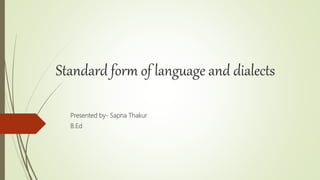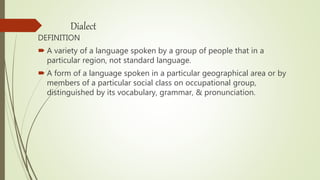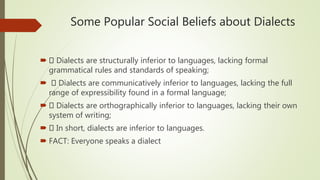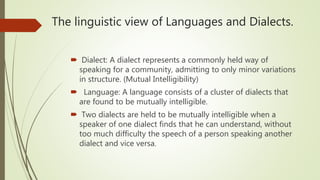Standard form of language and dialects
- 1. Standard form of language and dialects Presented by- Sapna Thakur B.Ed
- 2. Dialect DEFINITION ’é┤ A variety of a language spoken by a group of people that in a particular region, not standard language. ’é┤ A form of a language spoken in a particular geographical area or by members of a particular social class on occupational group, distinguished by its vocabulary, grammar, & pronunciation.
- 3. Characteristics of dialect: ’é┤1. Regional variety of a standard form. ’é┤2. The utterance of dialect is unique. ’é┤3. Maximum time using dialect s influenced by rural or urban socio-cultural aspects. ’é┤4. Dialect can be varied from geographical area to area. ’é┤5. A language could have more than one dialect.
- 4. ŌĆ£ A dialect is a form of language, peculiar to a specific regionŌĆØ language dialect dialect dialect dialect
- 5. Some Popular Social Beliefs about Dialects ’é┤ Dialects are structurally inferior to languages, lacking formal grammatical rules and standards of speaking; ’é┤ Dialects are communicatively inferior to languages, lacking the full range of expressibility found in a formal language; ’é┤ Dialects are orthographically inferior to languages, lacking their own system of writing; ’é┤ In short, dialects are inferior to languages. ’é┤ FACT: Everyone speaks a dialect
- 6. The linguistic view of Languages and Dialects. ’é┤ Dialect: A dialect represents a commonly held way of speaking for a community, admitting to only minor variations in structure. (Mutual Intelligibility) ’é┤ Language: A language consists of a cluster of dialects that are found to be mutually intelligible. ’é┤ Two dialects are held to be mutually intelligible when a speaker of one dialect finds that he can understand, without too much difficulty the speech of a person speaking another dialect and vice versa.
- 7. Dialect ’é┤ The word dialect was originally borrowed from Greek language. ’é┤ In ancient Greece, this word was used to refer to certain written varieties which were distinct from one another. ’é┤ But in English this term is used in a different sense
- 8. STANDARD LANGUAGE ’é┤ Standard language is an official form of language. ’é┤ This kind of form of languages are always artificially modified at least to some degree. ’é┤ Standard language is the way to use language in official and formal situation as in newspapers and public speeches. ’é┤ The core idea of standard language is to codify a public, particularly written language so that it is accessible to every speaker of the language to be used in education, media and science.
- 10. Differences between standard language and dialect: Many time people get confused with the aspect of language and dialect but there is some basic differences between language and dialect. Virtually dialect is one kind of form which derived from language. So, the differences are quite transparent and also inevitable. The main differences are: ’é┤ 1. Standard language can has huge speaker and expanded language area comparing that dialect has ’é┤ little small language area with less speaker. ’é┤ 2. Implicit difference can be seen in Pronunciation style, vocabulary and also in sentence structure. ’é┤ 3. Standard language is apprehensive for all dialect speakers where dialect is not. ’é┤ 4. Standard language can be used in every field but dialect has limitation in use.
- 11. ’é┤ 5. People follow Standard language in their writing system but there is no use of dialect in written language. If it use it cannot be approved by society. ’é┤ 6. Standard language is unbiased comparing dialect for public or common use. But dialect has more variation than standard. ’é┤ 7. Dialect is not approved in formal situation but standard form can be used in both formal and informal situation. ’é┤ 8. Standard language is considered as a prestigious language by society while dialect does not count as a prestigious language. ’é┤ 9. A standard language can represent all dialect under it. Dialect has not the power. ’é┤ 10. Standard language is not a formation of dialect but all dialects are formation of a standard language











